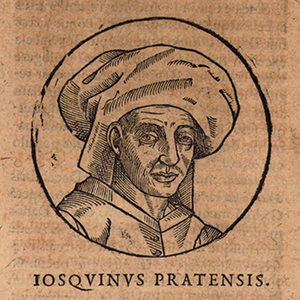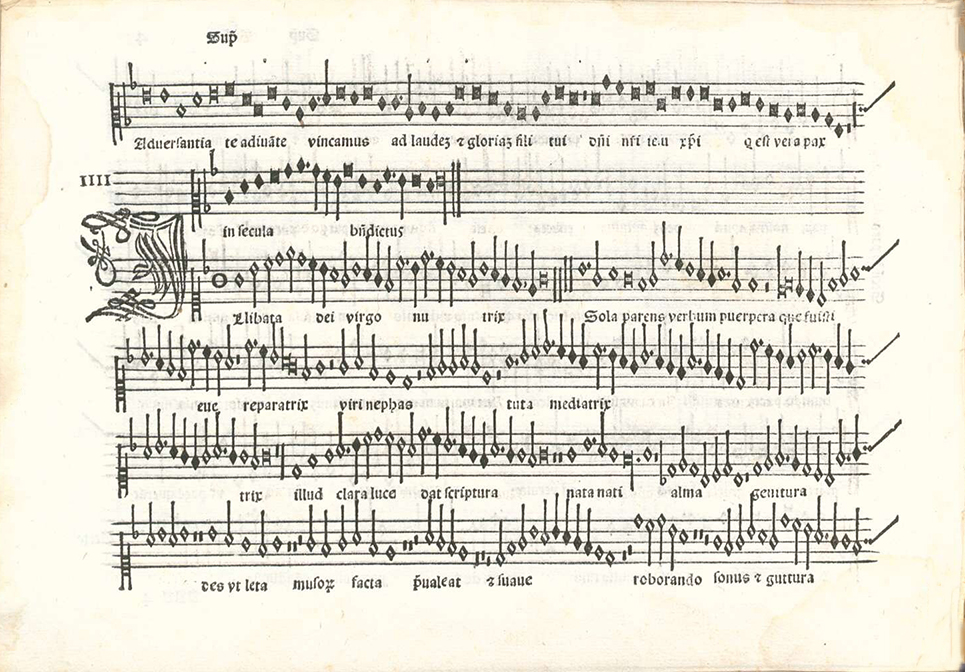Josquin Desprez died around 500 years ago, on 27 August 1521. This is one of the few certain dates in the life of the most famous composer of the 15th and 16th centuries, the period of transition from the Middle Ages to modern times.

Antwerpen 1611, S. 440
Quelle: Österreichische Nationalbibliothek, (A.001)
This phase, but especially the years from 1450 to 1550, are for me among the most fascinating years in history. The invention of printing (Gutenberg, around 1450), the discovery of America (Christopher Columbus, 1492), the Reformation (Martin Luther, 1517) and finally the Copernican revolution (from 1543, Nicolaus Copernicus) all fall into this period. All the events mentioned have changed the world permanently to this day.
During this phase, the dissemination of music also underwent a lasting change with the invention of music printing. For the first time, an “understanding of works” emerged (in contrast to the anonymity of the Middle Ages). Polyphony reached its first artistic peak and made its way out of the sacred environment.
The main protagonist of this era is Josquin Desprez. He is the first composer in music history to have a music print dedicated exclusively to him in “Misse Josquin”, by Ottaviano Petrucci (Venice 1502). His works were already in the first music print (with movable metal types) ever: Harmonice Musices Odhecaton A” (published on 15 May 1501).
Personal documents about Josquin are rare. The motet Illibata dei virgo is one of the few exceptions. It is not only a wonderful work, but also Josquin’s musical “business card”:

Quelle: Ottaviano Petrucci: Motetti a cinque Libro primo (Bayerische Staatsbibliothek, 4 Mus.pr. 168) (A.002)
The first letters of the individual lines of the motet text – read from top to bottom – form the name of the composer (IOSQVIN D PREZ). In the illustration, lines of text are missing because the bassus is pausing at this time:
Illibata Dei virgo nutrix,
Olympi tu regis o genitrix,
Sola parens Verbi puerpera,
Que fuisti Evae reparatrix,
Viri nefas tuta mediatrix,
Illud clara luce dat scriptura.
Nata nati alma genitura.
Des, ut laeta musorum factura
Praeveleat hymnus, et sit ave,
Roborando sonos ut guttura
Efflagitent, laude teque pura
Zelotica arte clamet ave.
The motet Illibata dei virgo is one of around 330 works attributed at least once to Josquin Desprez in 15th and 16th century sources. These works have survived in about 450 manuscripts and 150 prints. The majority of the tradition begins after Josquin’s death, and this is where the controversy in musicology begins. While there are no approaches to question Josquin’s authorship of the motet Illibata dei virgo, the situation is different for many of the 330 surviving works. The number of compositions attributed to Josquin has been significantly reduced in recent decades: The editors of the New Josquin Edition suspect, primarily on the basis of source studies, that over a third of the works were not composed by Josquin Desprez. Josquin’s authorship of over 40 other works has been classified as “dubious”.
Approach
Josquin made use of the most modern medium of his time and thus became the best known and most widely received composer of the Renaissance, while Josquin research to this day – with a few exceptions (e.g. https://www.josqu.in) – continues to take place in the over 500-year-old medium of print that made Josquin famous.
Monographic websites on Renaissance composers are rare. However, these offer precisely the opportunity to refer to current research results, to link to sources and to provide a forum for discussion.
Moreover, research on Renaissance music is predominantly aimed at connoisseurs of the subject. It is more difficult for interested amateurs to find access to the music. The texts are in Latin or French, the (mensural) notation differs from today’s notation, instead of today’s major/minor tonality, the works are based on Gregorian mode and the source situation and the associated abbreviations are confusing not only at first sight.
This is where my website comes in. The aim is to:
- To make Josquin’s work available and accessible to a wider audience, e.g. through a catalogue of works and sources and a discography,
- To enable discussion of the authenticity of works on a platform and to develop criteria that allow non-specialists to assess the degree of authenticity.
- To also provide interested researchers with a platform for discussion and thus to present current controversies to expert and amateur audiences alike.
For a first introduction at all, I recommend the personal listening recommendations of Alex Ross. These are an addendum to his very good article in The New Yorker magazine and can be found here: Alex Ross – A Listening Guide to Josquin Desprez. Ross has linked the recordings of “Cut Circle” under the direction of Josquin researcher Jesse Rodin directly on the website.